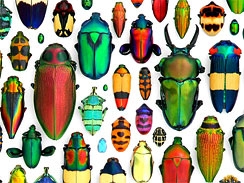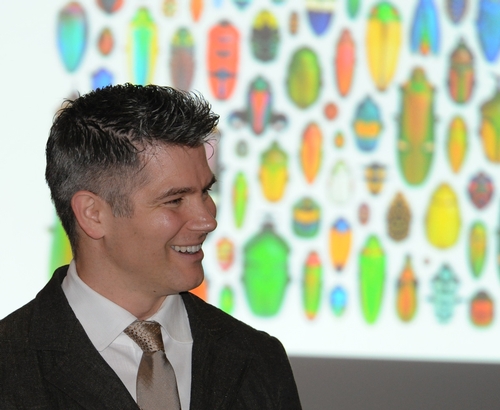
Speaking at the 58th annual Entomological Society of America's meeting in San Diego, Marley
related that he grew up in Oregon
hating bugs--especially their all encompassing, intertwining legs that seemed to be everywhere: on, near or around him. Later, while serving two years as a missionary in northern Chile, he continued to hate every bug that he encountered.
Gradually, his viewpoint changed. After studying fashion design at Brigham Young University and embarking on a fashion designer career that took him to scores of countries in Asia, Europe, Africa and the Americas, he began to look at them in a different light. He began to appreciate them for their beauty, design, color, structure, texture, pattern, size and shape.
And their drama and diversity.
His first attempts to incorporate them into art were not easy. "I needed tweezers to handle the tweezers," he said of his initial efforts to overcome the emotional barrier.
Today Christopher Marley is an author and an artist with an art gallery, fittingingly named "Pheromone" in Salem, Ore.
"Pheromones," he explained, "are chemical stimulants that insects release to attract one another -- and they’ve been known to seduce the occasional human, too."
Deeply interested in entomology, Marley can tell you the scientific name of many insects, their host plants, what the larvae eat, and when, where and how to find them.
Marley drew the entomologists into his kaleidescope world with photo after photo of his work featuring insects collected in such faraway places as Malaysia, Borneo, New Guinea and Kenya. The crowd sat mesmerized. You could almost hear a scarab beetle drop.
His 256-page book, "Pheromone: The Insect Artwork of Christopher Marley," has drawn worldwide attention in the print and electronic media. He sells his work (including colorful calendars) at hundreds of galleries and stores in the United States and abroad.
Marley told the entomologists he wants folks to appreciate insects--and he hopes that his art will inspire, educate and enlighten them.
Collecting insects is not as simple as hiring collectors, he said. He acknowledged that he fills out "reams" of paper work for the collecting permits, export permits and import licenses.
Not everyone likes the fact that he collects insects for art. One person once told him: "I love insects and I’d rather see YOU in the frame of that book."
And not everyone likes the fact that he employs catchers to collect the insects. Some insects found in the faraway corners of the world are quite rare or rarely seen.
"But it's not so much 'rare' species as 'rare' ecosystems or habitats," Marley told the entomologists.
Marley said by employing people from other countries as catchers, he is contributing to their well-being and that of their families; aiding the poverty-stricken areas; and teaching humankind to protect the habitat that provides those insects.
Marley quoted Baba Dioum: “In the end we will conserve only what we love. We will love only what we understand. We will understand only what we are taught.”
"I believe," Marley said, "that we will only love what we've experienced."
Attached Images:

Christopher Marley